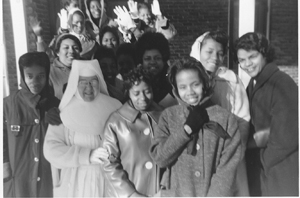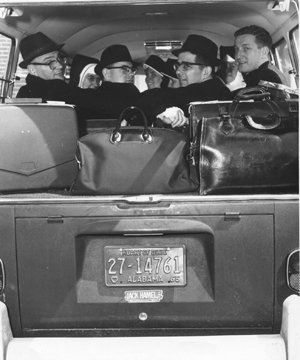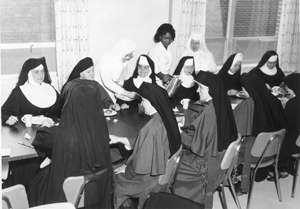Demythologizing Catholic Women Religious in the 1960s
Amy L. Koehlinger, Florida State University
I grew up in a world without nuns. Born and raised in a large enclave of Missouri-Synod Lutherans in the Midwest, I had very little contact with Catholics as a young person. In fact, I was 21 years old before I ever met a Catholic sister. Of course, I had plenty of ideas
¾false ones, as it turns out, based on anti-Catholic stereotypes of my childhood and images from popular culture
¾about who nuns were, what they believed, what motivated them, etc. I thought that sisters were medieval throwbacks, naïve dupes who had traded the moral responsibilities and physical autonomy of adulthood for the security of perpetual
infantilization under patriarchal, authoritarian religious structures. Which is why my first sustained encounter with a sister exploded everything I thought I knew about Catholic nuns, igniting a decade-long intellectual quest to discover exactly who these women really were. That quest culminated in my recently-published book
The New Nuns: Racial Justice and Religious Reform in the 1960s.
I met the first sister I got to know well under unusual circumstances: I lived with her. As a college student in the late 1980s I took a year hiatus from classes to volunteer for an HIV/AIDS service organization, Damien Ministries in Washington, D.C., a religious community of former and current Roman Catholic priests and brothers¾all HIV positive¾who ran shelters for homeless persons living with HIV/AIDS. Living and working with the men of Damien Ministries immersed me in Catholic liturgy and culture, and it also introduced me to the Catholic social justice tradition and to the subculture of radical Catholic activists that thrived on the margins of Catholic structures and institutions. The parade of visitors who came to share liturgy or meals at the Damien Ministries house included former priests, members of the gay Catholic group Dignity, associates of the anarchist Catholic Worker Movement, a diverse collection of Catholic pacifists and people who opposed U.S. policies in Latin America, and an assortment of Catholic sisters from the U.S. and from Ireland.
After several visits one of those visiting nuns, an octogenarian Marist Missionary Sister named Sister Anna, decided to join the Damien Ministries community. She moved into a room two doors down from mine in the community house. Her congregation had been founded in the nineteenth century by a group of women who left France to evangelize people living in the Pacific islands. By the time Sister Anna entered religious life the Marist Missionary Sisters had expanded the scope of their ministries to include educational and medical services. Anna had spent her 50 years of religious consecration serving in various medical clinics and schools in the Pacific, from Hawaii to Samoa. She had thin white hair that was cropped close to her head and thick-soled, black orthopedic shoes on her feet. She favored polyester pants and floral blouses gleaned from second-hand stores, but on chilly nights she donned a hipster leather jacket that she'd discovered in the Damien Ministries clothing bank. She used a floral-scented soap that filled the hallways with sickly-sweet odor after she showered, and she hung snippets of Rilke's poetry on her wall for inspiration.
 |
A Sister of Saint Joseph from Rochester, New York at the congregation's Good Samaritan Hospital in Selma , Alabama. "Good Sam," as the hospital was known in the community, was one of the few that served African-Americans prior to the 1960s. Courtesy of the archives of the Sisters of Saint Joseph, Rochester, New York. |
Sister Anna had a spry mind, a quick wit, and an intrepid attitude toward the financial and logistical challenges of ministry in a crowded, impoverished neighborhood. When she sent out letters soliciting donations for Damien Ministries, she delighted in saying aloud "send me some money" as she signed her congregation's acronym¾ S.M.S.M.¾behind her name. If you couldn't find Anna in her room or in the office, she was most likely in the chapel saying the rosary, her bony hand fingering a cheap plastic set of rosary beads ("It's a matter of poverty," she explained when I asked why her rosary was so modest).
Anna was not universally holy: she could be extremely difficult with people who transgressed onto her ministry "turf." I once saw her throw a temper tantrum complete with stamping feet and curled fists when one of the Damien priests took it upon himself to replace the flowers on the altar¾a task Anna considered hers alone. But Sister Anna also could be amazingly tender, sitting for hours at the bedside of ailing men¾most of whom had been abandoned by their families because of their AIDS diagnosis¾quietly stroking their withered hands while she prayed for the Heavenly Mother to comfort them.
In short, Anna was a human being, as complex and contradictory, vulnerable and resilient, petty and kind-hearted as anyone I'd known. I expected sisters to be sheltered, naïve, and passive in the face of male religious authority; Anna exhibited none of these characteristics. She was not an otherwordly saint, nor was she an innocent dupe to the Church's male hierarchy. Rather, Anna was educated and urbane, and she'd lived in more places in the world than I ever hoped to see in my lifetime. Her love of the Catholic tradition was not an immature love that blinded her to its faults or made her deferential in the face of the Church's considerable power structures. In fact, Sister Anna's devotion to the Church and its ministries seemed to have grown and matured in concert with her deepening knowledge of its shortcomings. She was as critical of the local bishop's dismissive attitude toward gay men and lesbians as she was devoted to Mary. But underneath it all, Sister Anna possessed a deep and (to me) mysterious spirituality that manifested itself in a fierce devotion to the suffering people she encountered.
| 
|
A Sister of Saint Joseph enjoys a rare snowy day with nursing students from the congregations' nursing school in Selma, Alabama. Sisters wore a white mission habit while working in Selma. These caucasian sisters in white habits were known casually in Selma as "the black nuns" because of their close association with the African American community. Courtesy of the archives of the Sisters of Saint Joseph, Rochester, New York. |
Living with Sister Anna obliterated all of my stereotypes of Catholic sisters, but the experience also sparked my curiosity. Other sisters I encountered at Damien Ministries convinced me that Anna was not an anomaly; she was, in fact, fairly representative of a particular generation of Catholic sisters who had entered religious life between the 1930s and 1960s. Which left me wondering: where did these women come from? What was it about the Catholic Church at mid-century that had encouraged some girls to pursue education and public ministry at a time when American culture strongly compelled most girls (Catholic and non-Catholic alike) to pursue motherhood and domesticity? What forces shaped these sisters, gave them such a strong vision of social justice and a clear commitment to living among the poor? What challenges and limitations had they faced during their careers? How had women who were this strong-willed and independent been able to negotiate a place of their own within a Church that was governed exclusively by men at the highest levels?
When I began graduate training in the history of American religion those questions stayed with me, animating my choice of research topics. Ultimately, those questions lay at the heart of The New Nuns. The book documents the development of a "racial apostolate" among white Catholic sisters in the early 1960s, when nuns created a network of programs that addressed both the social causes of racial segregation and its concrete effects on African Americans. The New Nuns details the diverse ways that white Catholic sisters participated in the later stages of the civil rights movement, exploring how sisters' ideas about religious consecration, apostolic mission, and gender were transformed by their immersion in African-American communities in the urban North and Jim Crow South.
Through this focus on one particular form of social activism by nuns, the book attempts to demythologize Catholic women religious, replacing monochromatic stereotypes of sisters with a more complex representation of their lives in a particularly thick historical moment. The New Nuns offers a detailed portrait of sisters at a time when social and religious change had destabilized their institutions and their identities. Drawing on personal correspondence, nuns-only newsletters, and interviews with sisters, the book highlights the voices and the perspective of sisters as they reflected on their motivations for joining civil rights activism, their relationships with superiors and the male hierarchy as they negotiated unconventional apostolic assignments, and the ways that immersion in black communities changed their ideas about what it meant to be a sister.
 |
Sisters of Saint Joseph picking up visiting Catholic civil rights marchers from the airport. Though they were prohibited from participating directly in the civil rights marches in Selma in 1965, the Sisters of Saint Joseph contributed to the civil rights movement by treating marchers who were injured by police attacks on "Bloody Sunday," and hosting protesters who came from other cities to join the final march to Montgomery. Courtesy of the archives of the Sisters of Saint Joseph, Rochester, New York. |
For Catholic sisters, the 1960s was a time of profound instability. By virtue of their ministries and public works, sisters in apostolic congregations had one foot firmly planted in American society and so experienced the same cultural upheavals and social transformations as their fellow citizens in this crucial decade. By virtue of their religious consecration, sisters also inhabited the interior folds of a Catholic world that was on the cusp of its own revolution as the Church prepared for and then absorbed the dramatic changes that resulted from the Second Vatican Council (1962-65). On yet another level, the very institution of religious life was destabilized in this period as congregational superiors struggled to implement innovations that had emerged from a two-decade long process of organizational reform to the ways that sisters in the U.S. were recruited, educated and trained (or "formed") for religious consecration and apostolic ministry. Thus, American sisters in the civil rights era inhabited multiple unstable worlds as circumstances both inside and beyond convent walls forced them to negotiate and renegotiate their roles as the ground shifted constantly beneath their feet. Sisters generally describe (and still remember) this time as one of equally intense optimism and insecurity.
In this volatile context, a considerable number of sisters abandoned traditional assignments in Catholic schools and hospitals in order to participate in works promoting racial justice. Sisters volunteered to teach at traditionally African American colleges in the South. They held racial sensitivity training sessions in parish neighborhoods experiencing integration. They sustained urban parish schools after white students left for segregated suburban neighborhoods. They marched at Selma and in Selma sympathy marches. They initiated "urban apostolate" programs in northern black neighborhoods and public housing projects.
A complicated matrix of impulses and agendas¾not all of them purely altruistic¾ motivated sisters who participated in racial justice movements in the 1960s. Catholic nuns who sought assignments in racial apostolate programs were attempting to secure fundamental human and civil rights for Americans of African descent, to be sure, and many sisters were eloquent and even passionate in their explanations of why racial justice was vital to American society. But for the women religious I studied, the larger goal of racial justice was inextricably linked with a diverse array of other, more intimate motivations¾to free themselves of rigid structures of convent life, to experience what they considered to be a more pure apostolate, to escape the growing racial segregation inherent in the postwar suburbanization of white Catholics, to apply social scientific theories they had learned in religious formation, or to be closer to a people they believed had been made holy through their suffering.
 |
Sisters of Saint Joseph serving a meal to visiting sisters who came to Selma in support of civil rights efforts there in 1965. The variety of religious habits among sisters at the table reflects the diverse nature of the "racial apostolate" of sisters, which attracted women from a broad spectrum of religious orders and congregations. Courtesy of the archives of the Sisters of Saint Joseph, Rochester, New York . |
Conflict was endemic to the racial apostolate. The bureaucratic process through which individual sisters became directly involved in the racial apostolate often was quite volatile. Such work raised to the surface of religious congregations certain latent conflicts and tensions that were normally less visible or less operative in the normal course of the community's apostolic works within Catholic schools and hospitals. Work among African Americans often put sisters in conflict with other sisters, with their superiors or their congregations. Because it usually required sisters to live and work outside of convents and Catholic institutions, the racial apostolate also challenged traditional ideas about religious enclosure and the form of religious community appropriate for women dedicated to religious consecration. It produced controversial reforms that at times deepened conflicts both within religious communities and between sisters and the male hierarchy. Beyond convents and religious congregations, some lay Catholics interpreted the racial apostolate as a direct criticism of increasing segregation and suburbanization among white American Catholics¾which it was.
Despite the pervasive air of discord that often surrounded it, the racial apostolate also embodied the hope and creativity of sisters in a period of profound religious and institutional unrest. The experience of sisters in the racial apostolate was thus one of creativity born of conflict, and of hope within confusion and frustration. To encounter the experience of sisters from this period is to enter a highly-charged world, where the outcome¾for individual sisters and for the institution of religious life¾was uncertain. It is my hope that in bringing readers close to the experience and perspective of sisters in this critical era, The New Nuns will create a deeper appreciation among historians for the intricacy, the humanness, and the importance of women religious as historical subjects.

